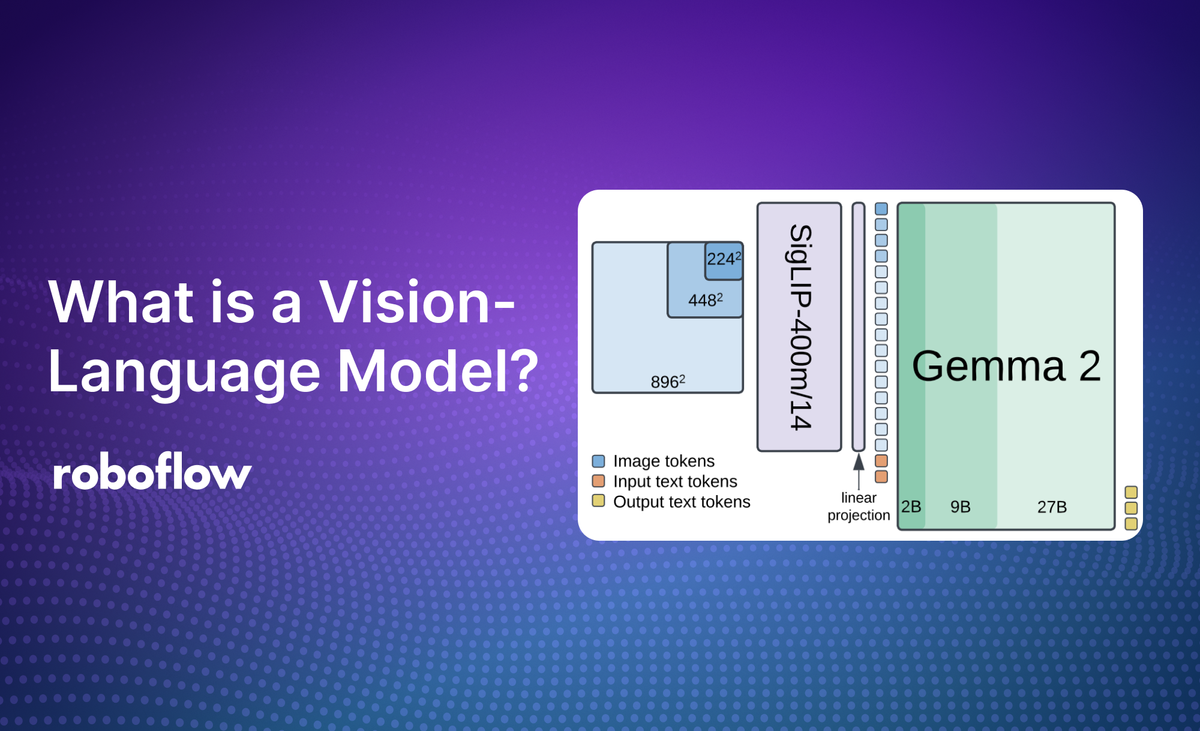
What is a Vision Language Model?
A Vision-Language Model (VLM) is an advanced artificial intelligence system designed to process and combine visual (image) and textual (language) data. Vision-language models are at the intersection of computer vision and natural language processing (NLP) which enables machines to understand, interpret, and generate content that involves both images and text.
LMs can be classified as generative AI when they are designed to generate outputs, such as text descriptions, images, or answers, based on visual and/or textual inputs. VLMs are a subset of multimodal models because they process and integrate multiple types of data, specifically visual (images, videos) and textual (language) information.
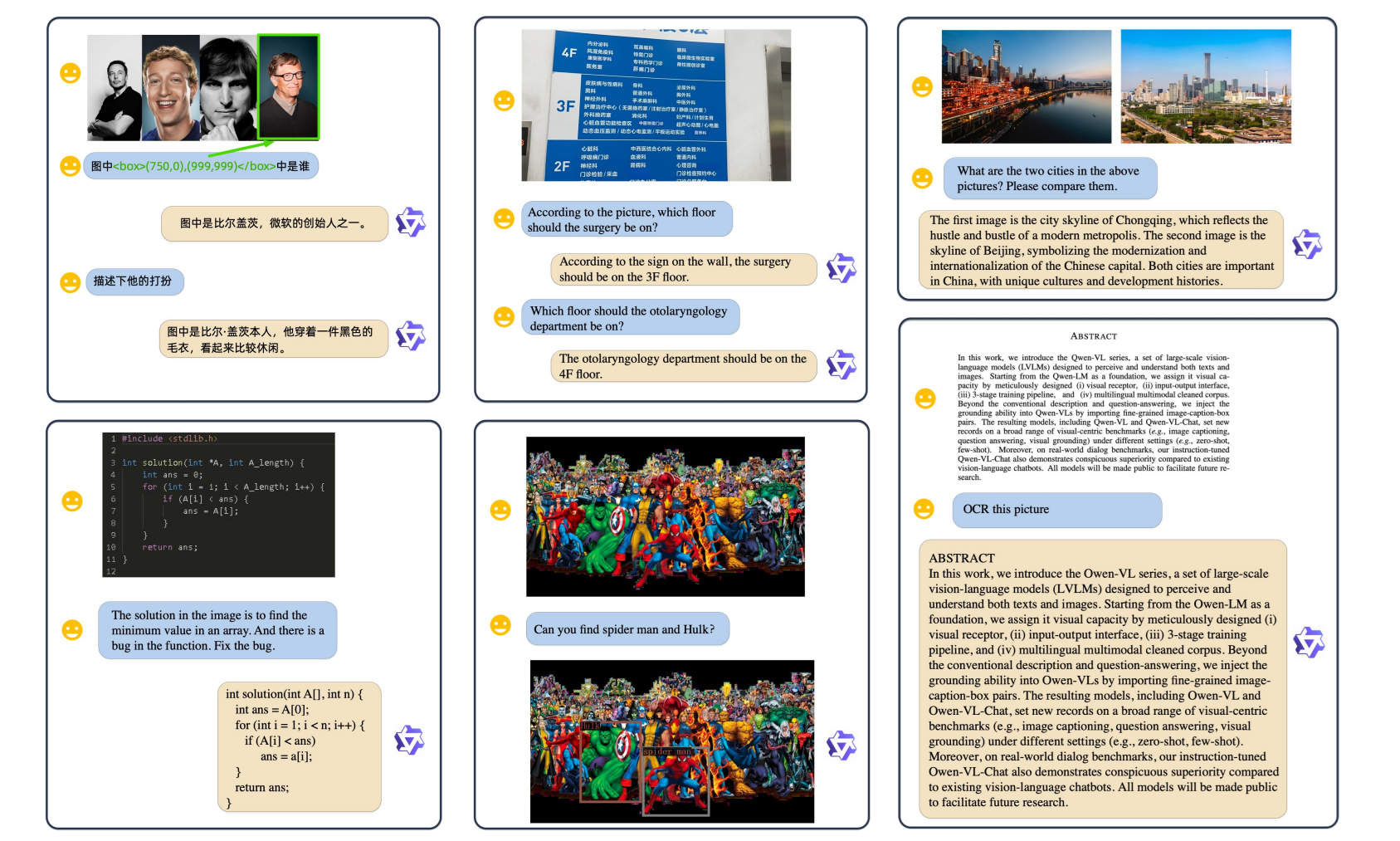
How Do Vision-Language Models Work?
VLMs are designed to process and integrate visual and textual information which enable them to perform tasks that require understanding both images and text. VLM architecture comprises several key components that work together to achieve this multimodal understanding. The general VLM architecture is shown in image below.

The core components of general VLM architecture consists of the following:
- Image Encoder
- Text Encoder
- Multimodal Fusion
- Decoder
Image Encoder (Vision Encoder)
The image encoder processes visual data (e.g., images) and transforms it into numerical feature representations (embeddings) that can be used for multimodal learning. Vision encoders are categorized into three types: object detector (OD), convolutional neural networks (CNN), and vision transformers (ViT).
Object Detector (OD):
OD identifies and localizes objects in images by generating region-based embeddings. It encodes visual features and spatial location information which is essential for understanding object relationships in vision-language tasks.
Convolutional Neural Networks (CNN)
CNN extracts hierarchical visual features from images, ranging from simple patterns to complex structures. CNN serves as a backbone for tasks requiring feature-rich image representations, improving performance on downstream applications.
Vision Transformers (ViT)
ViT processes images as sequences of patches, capturing global context and relationships. It offers flexibility in modeling complex visual dependencies, making it effective for vision-language pretraining.
Text Encoder
The text encoder processes textual input to generate feature-rich representations for use in multimodal learning tasks. It translates input sentences into a sequence of vectors that capture semantic and contextual information.
Multimodal Fusion
Multimodal fusion combines the embeddings from the image and text encoders to create a unified representation that integrates both modalities. The result is a fused multimodal embedding that captures relationships between visual and textual elements. It uses the following mechanism:
Merged Attention
Aligns image and text features by attending to relevant regions of the image and words in the text simultaneously.
Co-Attention
Co-Attention is a mechanism that facilitates the simultaneous interaction between visual and textual modalities, enabling the model to focus on relevant parts of both the image and the text.
Dot-Product
Measures the similarity between image and text embeddings in a shared embedding space, often used in retrieval tasks.
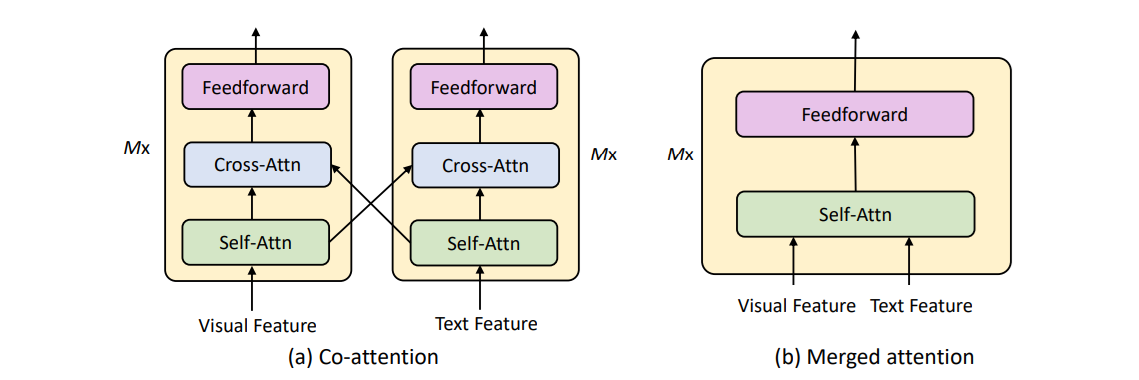
Decoder
Decoder generates the final output based on the fused multimodal representation.
Popular Vision-Language Models
In this section we will explore some of the popular VLMs with their key capabilities.
Paligemma-2
PaliGemma 2 is a vision-language model developed by Google, building upon its predecessor, PaliGemma. It integrates the SigLIP-So400m vision encoder with the Gemma 2 language models, resulting in a versatile system capable of understanding and generating both visual and textual data.
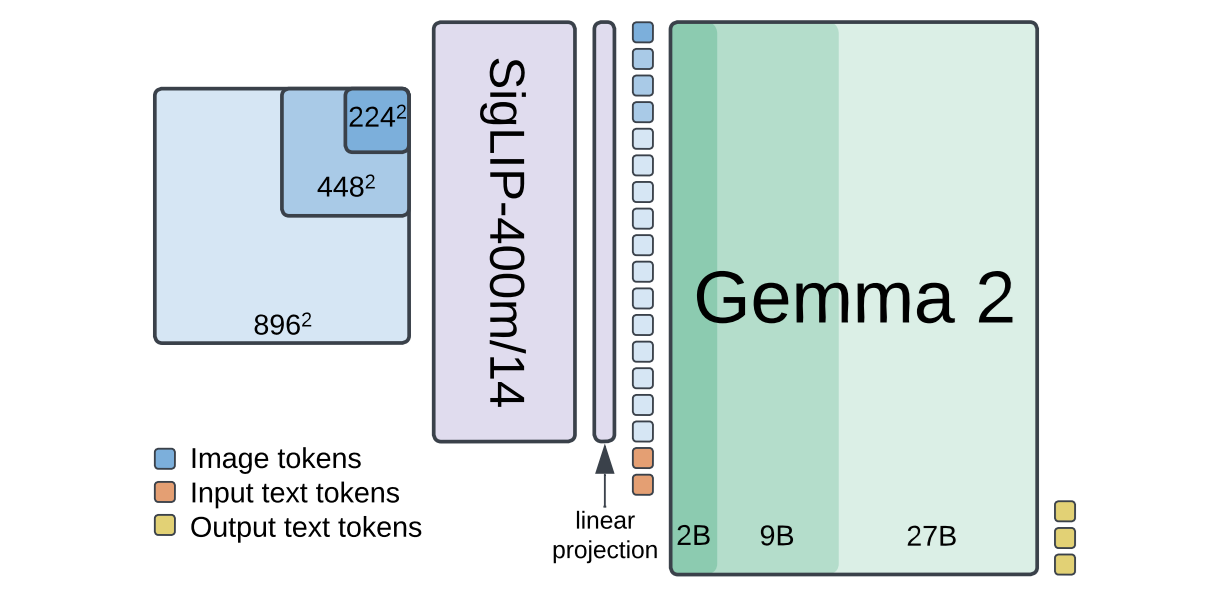
The following are the key capabilities of PaliGemma-2:
- Image Captioning: PaliGemma 2 can generate detailed and contextually relevant captions for images.
- Visual Question Answering (VQA): The model can answer questions related to the content of images with deep understanding of visual contexts.
- Optical Character Recognition (OCR): PaliGemma 2 excels in recognizing and processing text within images which makes it effective for document analysis and text extraction tasks.
- Object Detection and Segmentation: Paligemma 2 can detect and identify objects within images. Paligemma 2 also supports instance segmentation task.
- Domain-Specific Applications: PaliGemma 2 has demonstrated leading performance in specialized areas such as chemical formula recognition, music score recognition, spatial reasoning, and chest X-ray report generation.
- Fine-Tuning and Adaptability: Paligemma 2 can be fine-tuned on custom dataset for object detection and segmentation tasks which enables adaptation to a wide range of downstream tasks.
Florence-2
Florence-2 is a vision foundation model developed by Microsoft. It is designed to handle a wide range of computer vision and vision-language tasks through a unified, prompt-based approach. Florence-2 can interpret text prompts to perform tasks such as image captioning, object detection, grounding, and segmentation.

The following are the key capabilities of Florence-2:
- Image Captioning: Florence-2 can generate detailed descriptions of images by capturing both high-level scenes and fine-grained details.
- Object Detection: The model identifies and localizes various objects within an image and provides bounding boxes and labels for each detected item.
- Visual Grounding: Florence-2 associates textual phrases with corresponding regions in an image which enable it to focus on specific elements based on descriptive prompts.
- Segmentation: Florence-2 can be used for segmentation tasks. It identifies and outlines objects or areas in an image down to the pixel level.
- Unified Prompt-Based Representation: Florence-2 understands different tasks using simple text instructions. This approach enables the model to generate desired outputs like generating captions, OCR, visual grounding, object detection or segmentation etc.
CogVLM
CogVLM is an open-source visual language foundation model designed for vision-language tasks. CogVLM integrates visual and textual data by incorporating a trainable visual expert module within the attention and feedforward neural network layers of a pretrained language model. This deep fusion approach enables CogVLM to effectively combine visual and linguistic features without compromising performance on natural language processing tasks. The model achieves state-of-the-art results on multiple cross-modal benchmarks.
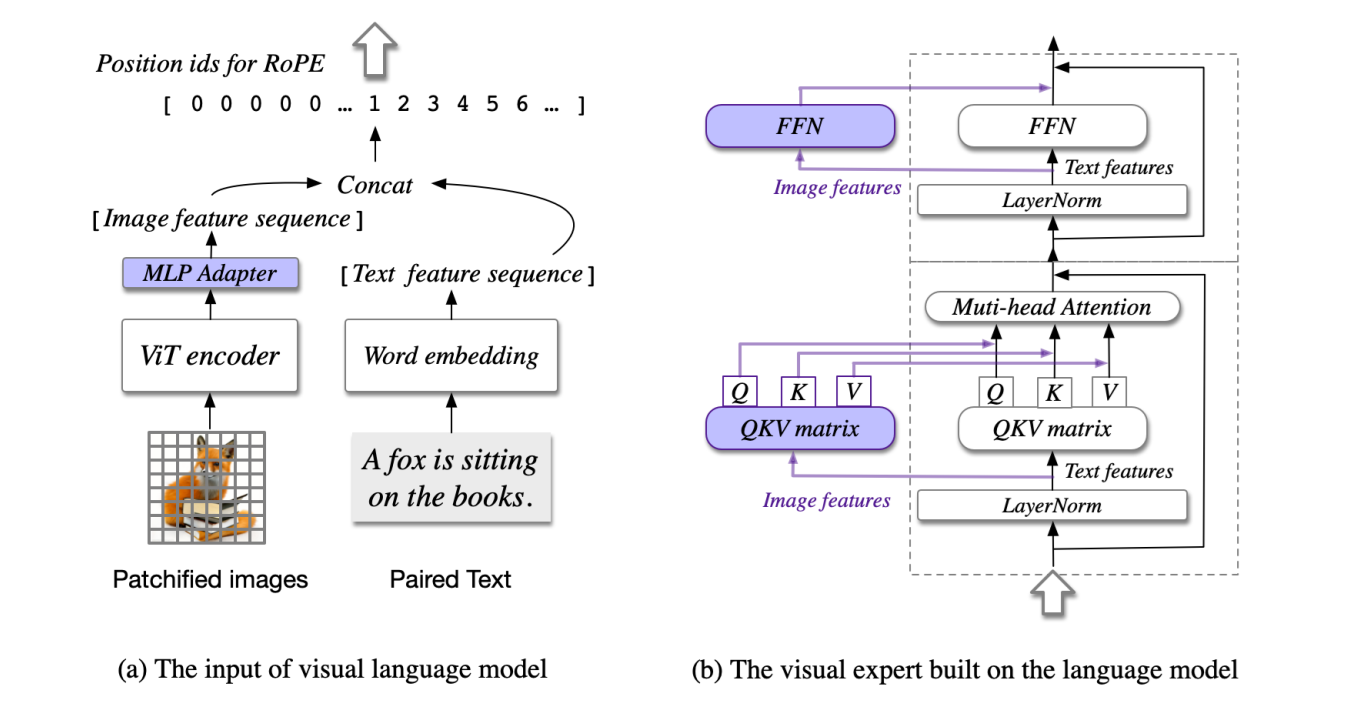
The following are the key capabilities of CogVLM.
- Detailed Descriptions: CogVLM provides detailed and contextual explanations of visual content.
- Visual Question Answering: CogVLM can analyze visual data to answer complex questions with contextual details.
- OCR-Free Reasoning: The model performs reasoning on images without relying on explicit OCR outputs.
- Programming with Visual Input: CogVLM can work with visual data as input to perform programming tasks.
- Grounding with Caption: The model associates textual descriptions with specific coordinates in an image. It can detect objects in image and provide their exact coordinates.
- Grounding Visual Question Answering: CogVLM grounds specific visual details while answering questions. For example, determining the color of clothes worn by a person in an image by identifying relevant objects and attributes.
- Image Understanding: CogVLM is highly capable of understanding what is in the image. It can process visual representations of data structures (like linked lists) in the image and generate appropriate programming solutions in a specified language. CogVLM can also interpret data visualizations such as charts and mathematical notations and provide reasoning.
Llama 3.2-Vision
Llama3.2-Vision is a multimodal extension of Meta’s Llama family of models. It is designed to handle both text and visual data. Llama3.2-Vision integrates an image encoder with Llama’s language architecture. Llama3.2-Vision can perform tasks like object recognition, scene understanding, image captioning, and visual question answering. While performing these tasks it maintains Llama’s strong abilities in text-based understanding and generation.
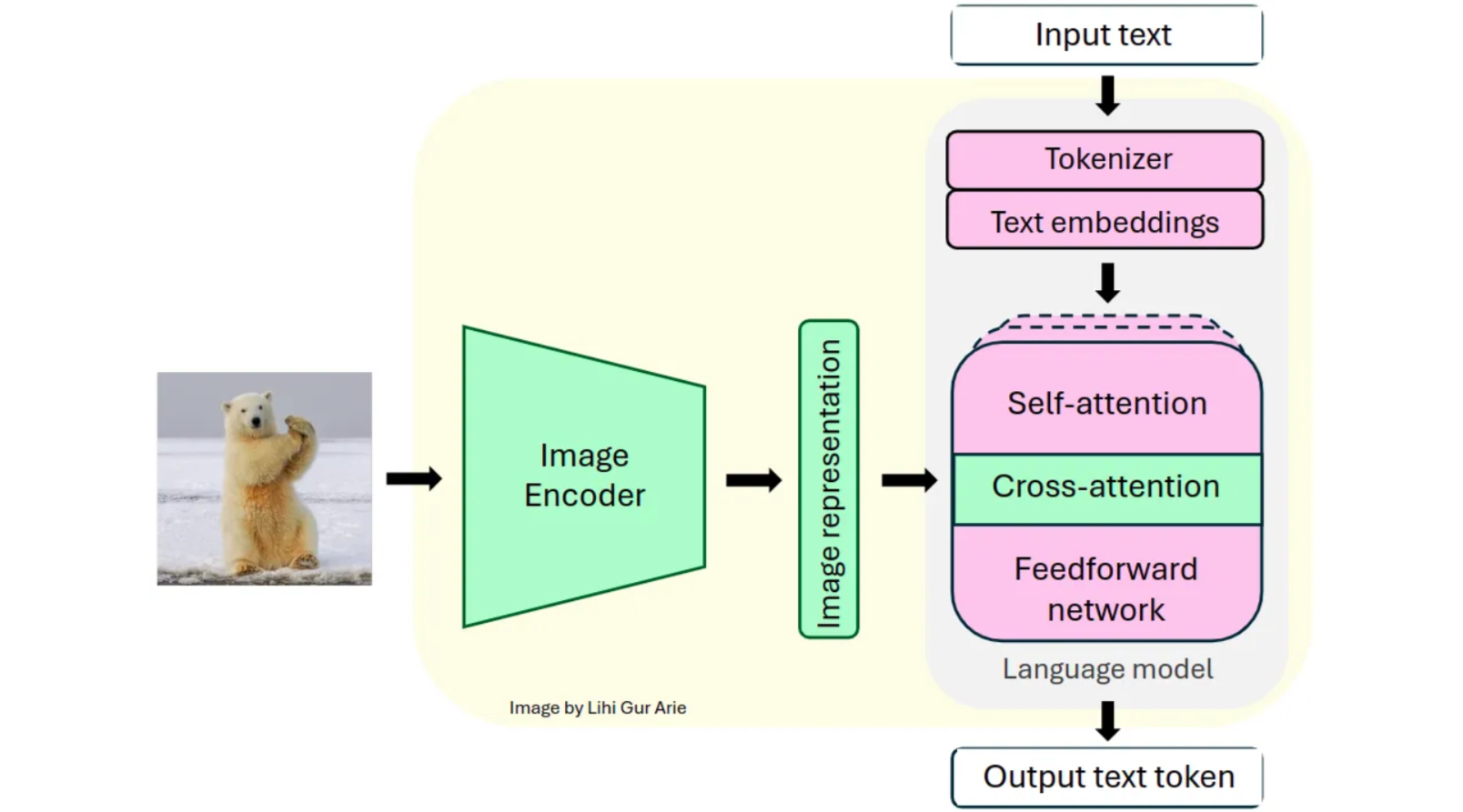
The following are the key capabilities of Llama3.2-Vision.
- Visual Recognition and Image Reasoning: Llama3.2-Vision can analyze images to identify objects, interpret scenes, and understand visual contexts. This capability allows the model to perform tasks such as object recognition and scene analysis.
- Image Captioning: The model can generate descriptive captions for images and effectively summarize visual content. It is used to generate description of images.
- Visual Question Answering (VQA): Llama3.2-Vision can answer questions related to the content of images. It is capable of understanding both visual elements and associated textual queries. This includes tasks like identifying specific objects within an image or explaining visual scenes.
- Optical Character Recognition (OCR): Llama3.2-Vision is capable of recognizing and interpreting text within images to transcribe handwritten notes, printed documents, or text within photographs. It is used for digitizing written content and extracting information from images.
- Chart and Table Analysis: Llama3.2-Vision can interpret and analyze visual data representations such as charts and tables and extract meaningful information from it and provide summaries or explanations of the data presented.
- Handwriting Recognition: Llama3.2-Vision can accurately transcribe handwritten text from images assisting in digitization of handwritten notes and documents.
Qwen-VL
Qwen-VL is a large-scale vision-language model developed by Alibaba Cloud, designed to process and understand both textual and visual information. Building upon the Qwen-LM foundation, it integrates visual capabilities through a meticulously designed architecture and training pipeline. There are different variants of Qwen-VL, such as Qwen-VL, Qwen-VL-Chat, and Qwen-VL-Max. These are specialized versions designed for specific applications.
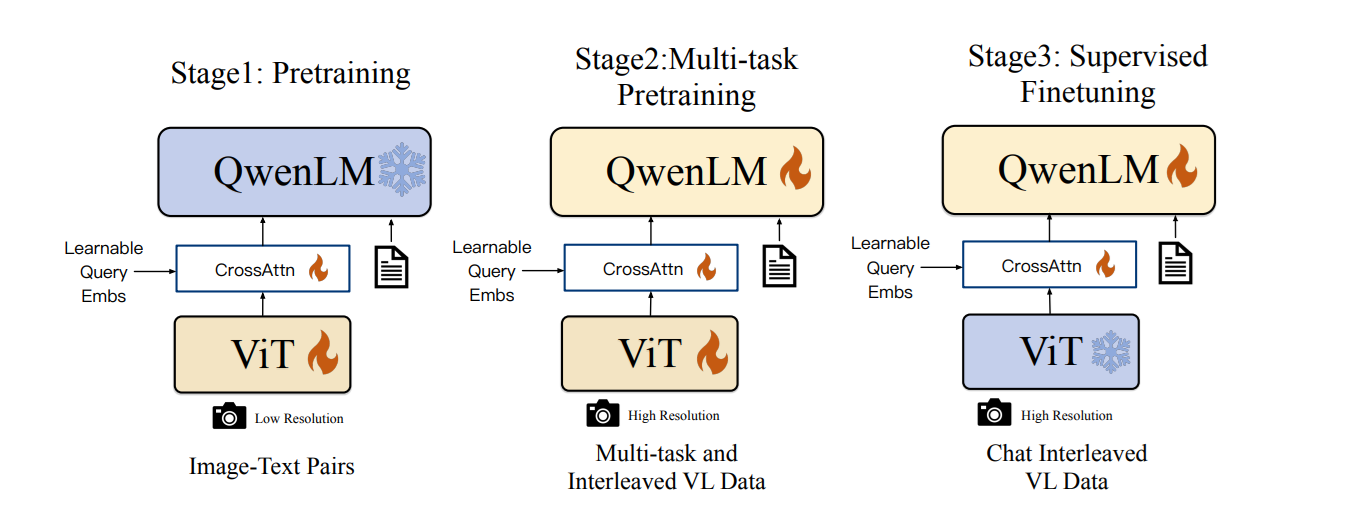
The following are the key capabilities of Qwen-VL:
- Image Recognition and Description: Qwen-VL can identify and describes various elements within the input images including common objects, celebrities, and landmarks etc.
- Visual Question Answering (VQA): Qwen-VL answers questions related to image content by understanding its visual context. It responds to queries about specific objects or scenes depicted in images.
- Visual Grounding: Qwen-VL finds and locates the corresponding region in the image based on textual phrases. It provides the bounding box and label for the region that matches the textual phrases.
- Text Recognition (OCR): Qwen-VL efficiently extracts and processes text from images including tables and documents.
- Multilingual Support: Qwen-VL naturally supports English, Chinese, and multilingual conversations and promot end-to-end recognition of bilingual text in images.
- Advanced Visual Reasoning: Beyond basic image description, Qwen-VL can interpret and analyze visual representations such as flowcharts, diagrams, and symbolic systems. It can perform problem-solving tasks from visual data including mathematical reasoning and in-depth interpretation of charts and graphs.
Vision Language Model Use Cases
In this section we will explore the different computer vision tasks which can be possible using VLMs. We will use two popular VLMs, Meta Llama 3.2V and Google Gemini, for our examples. We will use Roboflow Workflows for our examples that shows how to use VLMs for various tasks.
Image Classification
Image Classification is the fundamental task in computer vision. it is like giving model a photo and asking "What is this?" The model analyzes the image and assigns it to one or more predefined categories. For example, when shown a photo of a golden retriever, the model would classify it as "dog" or more specifically "golden retriever." This is a basic task and forms the basis for more complex visual understanding tasks. We can build an image classification application with Roboflow Workflow without writing code.
To do this create a new workflow, and add Llama 3.2 Vision, VLM as Classifier and Classification Label Visualization Blocks to it as shown below.
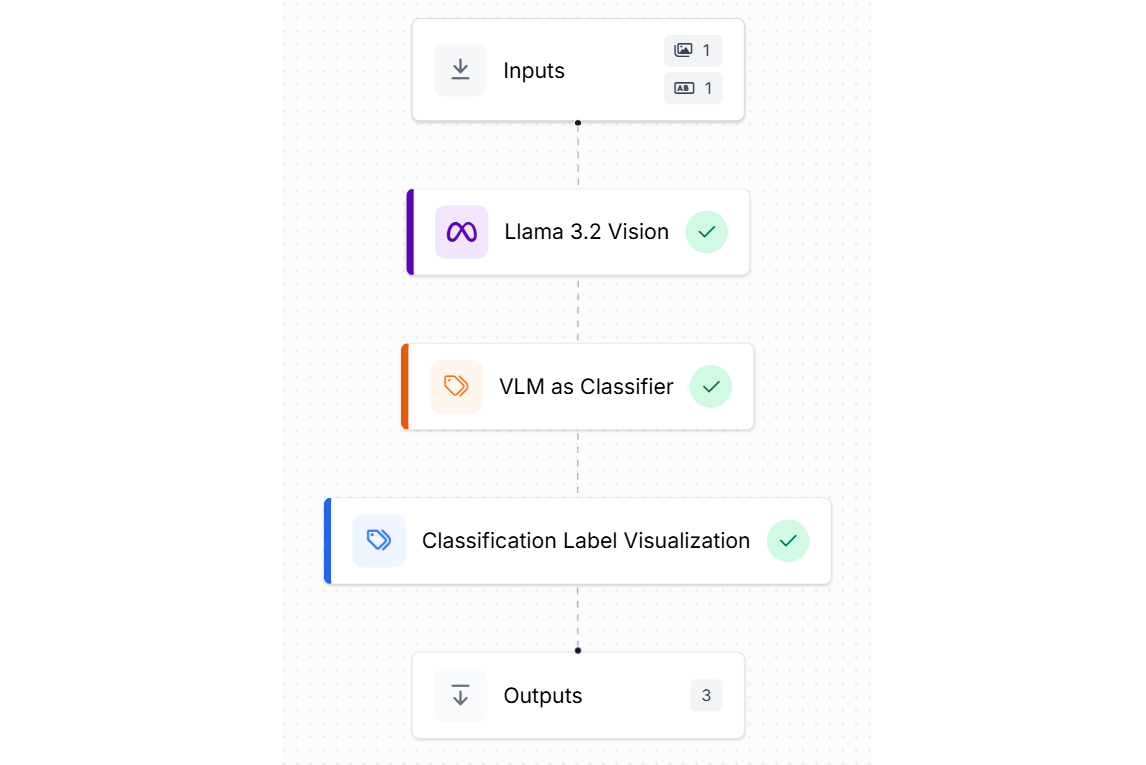
Now we will see the configurations for each blocks. The Input block should be configured to accept class labels in the “labels” parameter and image in the “image”. I have also specified the two default classes in my “labels” parameter as a python List object.
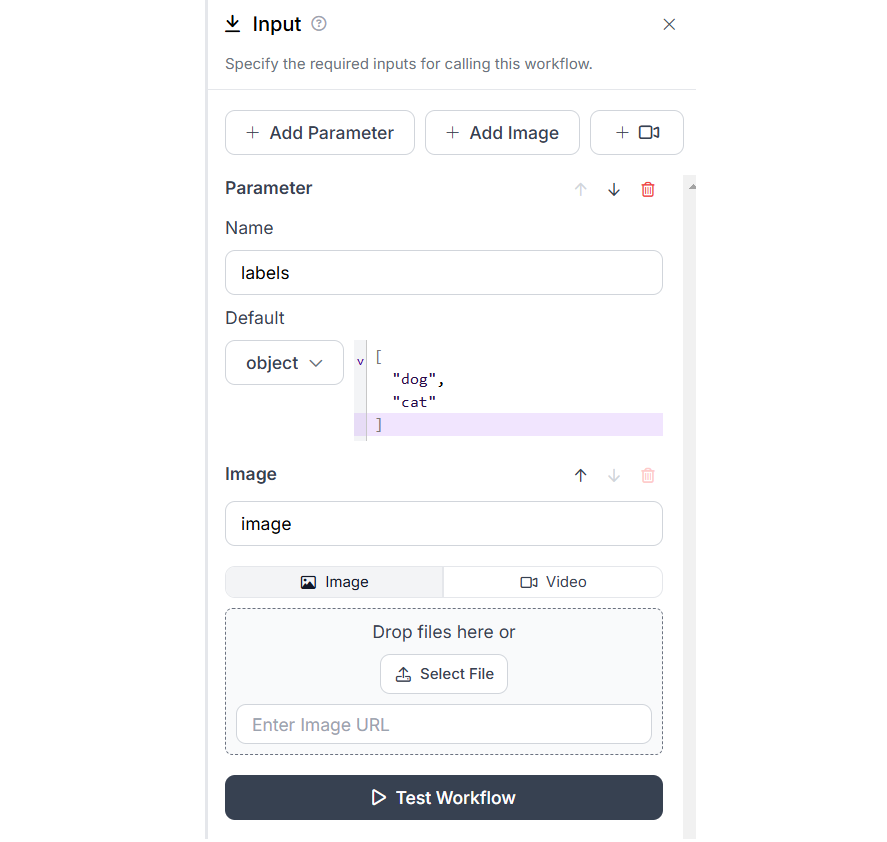
Next you need to configure Llama 3.2 Vision block. In this block specify task type as “Single-Label Classification”, the classes field should be bind with “labels” parameter that we have specified in the input block in above step. Specify you Llama Vision API key obtained from OpenRouter. The Llama 3.2 Vision block must look like following.
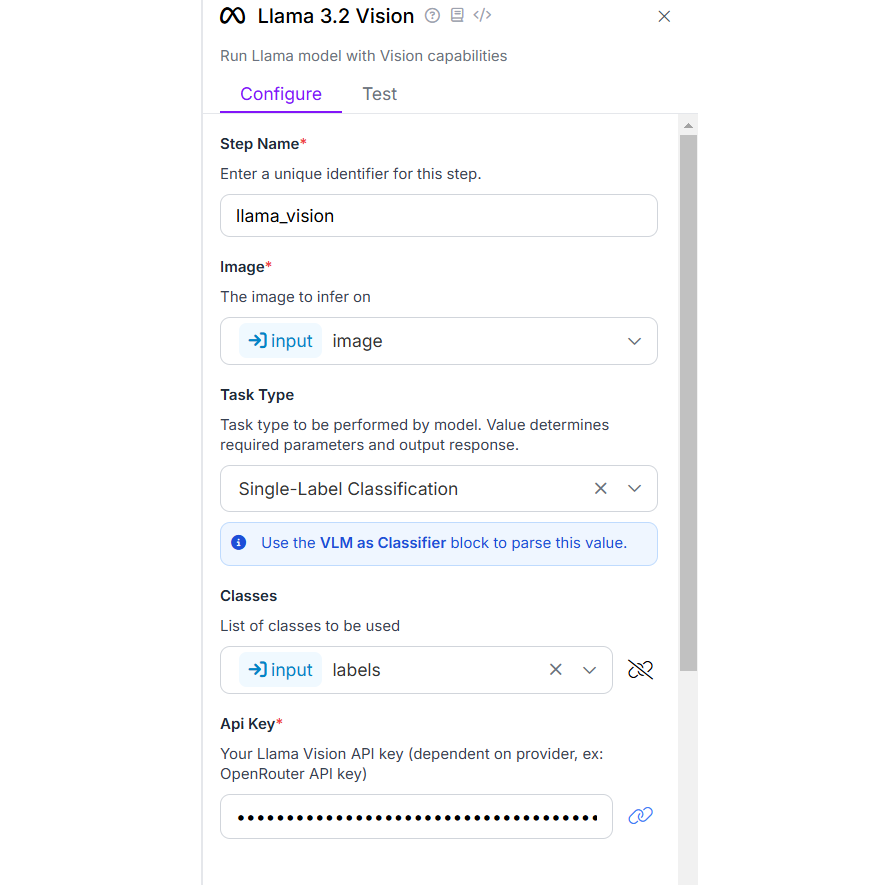
The next block is VLM as Classifier block. This block gets string input from our Llama 3.2 Vision block. Input is then parsed to classification prediction and returned as block output. Following is the configuration for this block.
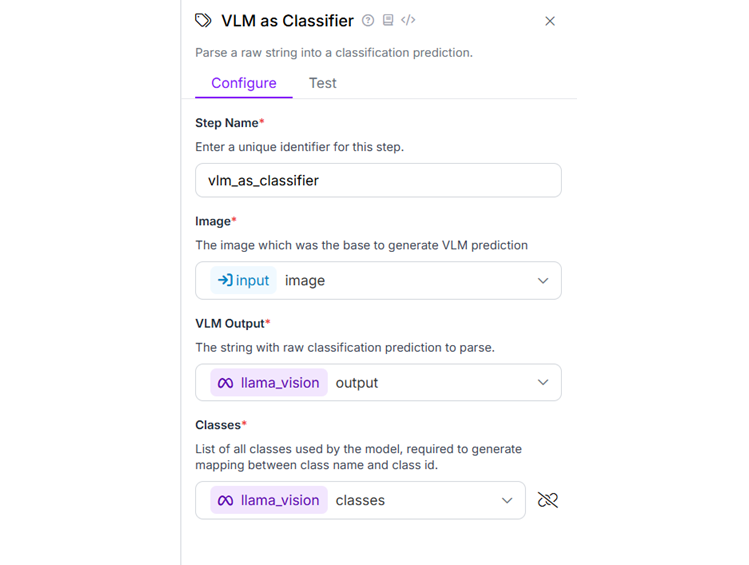
Now, configure the Classification Label Visualization block. This block visualize both single-label and multi-label classification predictions with customizable display options. Use following configurations and keep other default.
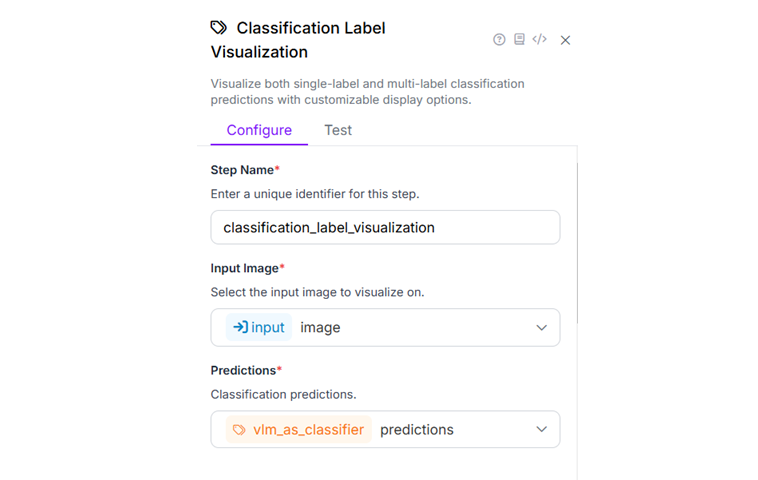
Finally, the Output block should look like following.
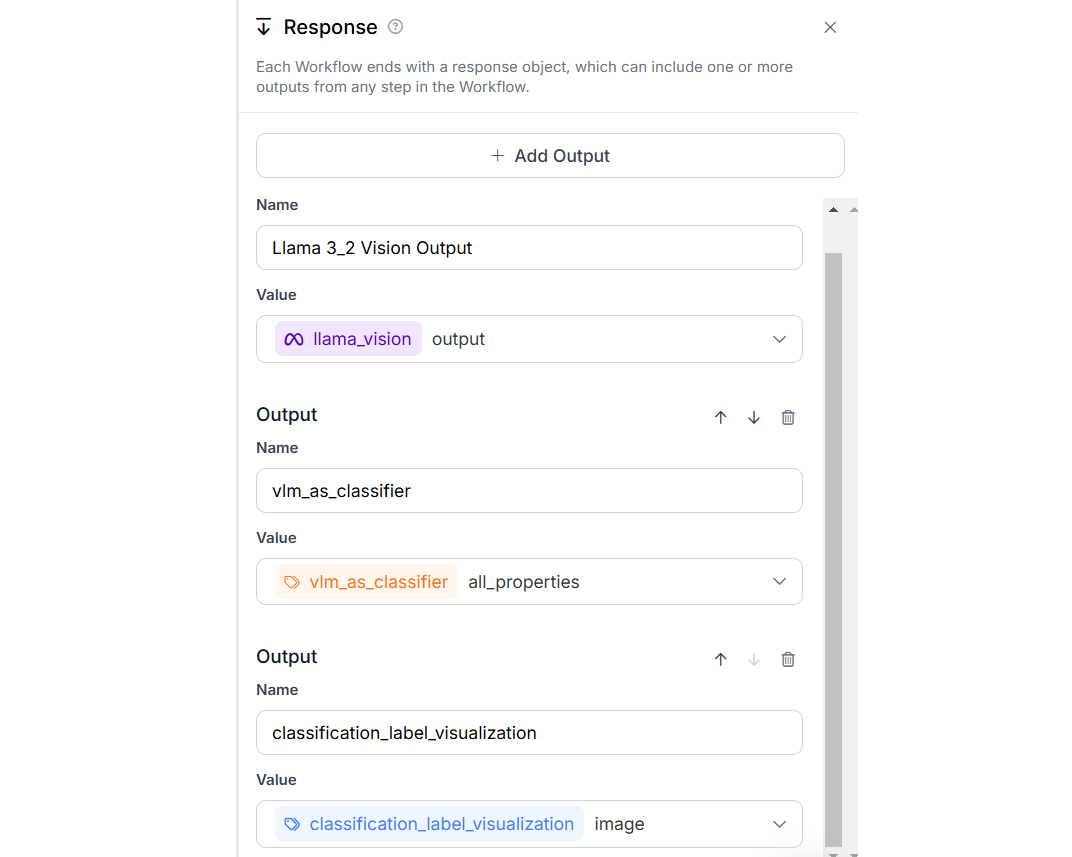
Here is the output after running Workflow. I have uploaded image of a “dog” and it was classified as “dog” with high confidence. You can try with any other image and specifying the new class labels. In the output from this Workflow, you will see image with classification label.
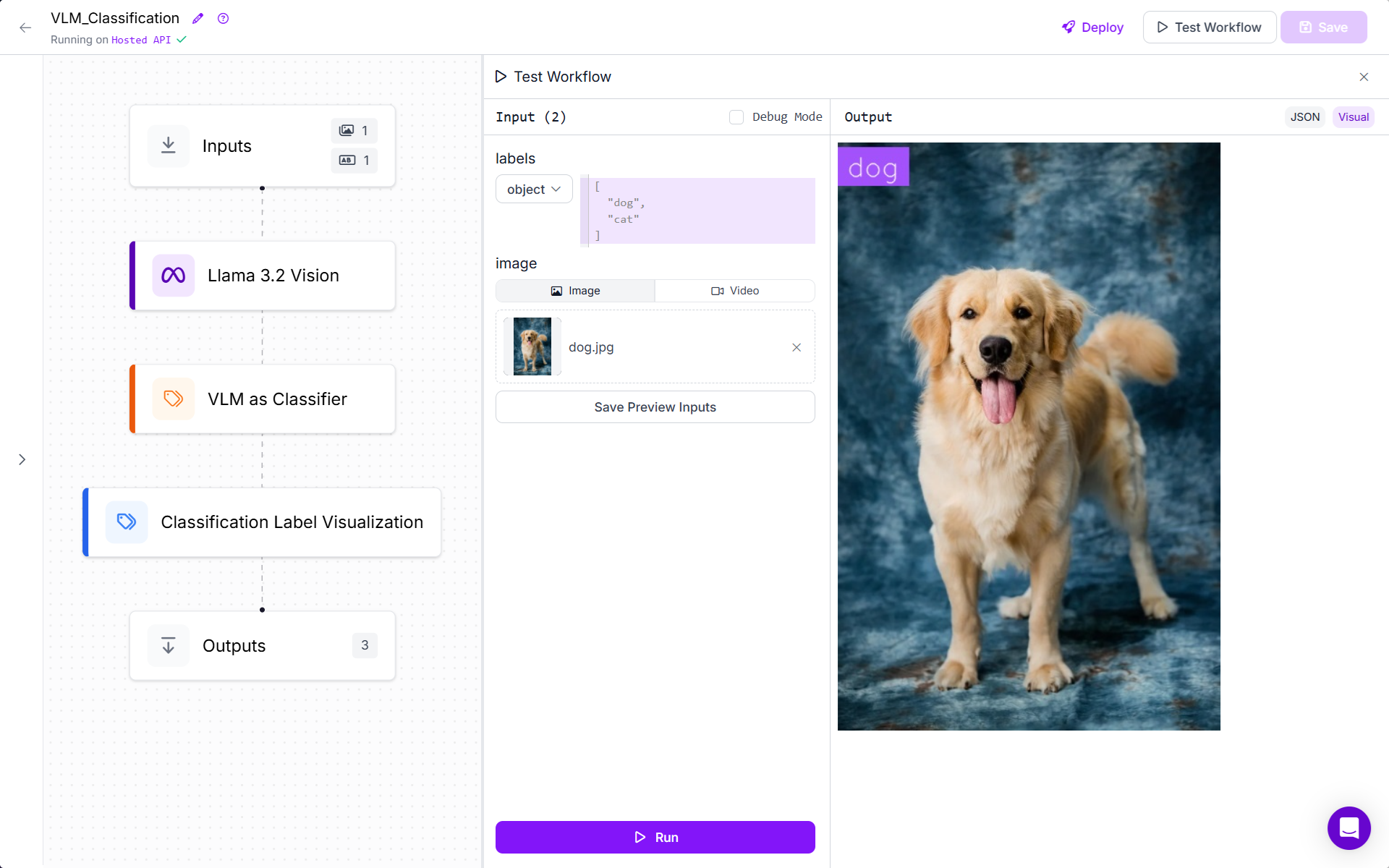
Object Detection
Object Detection takes classification a step further by not only identifying what objects are present but also locating them within the image. The model draw bounding boxes around the detected objects and also provides labels to each detection. Imagine looking at a busy street photo, the model would identify and draw boxes around cars, pedestrians, traffic lights, and other objects, labeling each one. This requires understanding both what objects are and where they exist in spatial relationships to each other. To show case object detection using VLM, we will use Google Gemini model with Roboflow Workflow. The workflow that we create for our example will look like following.
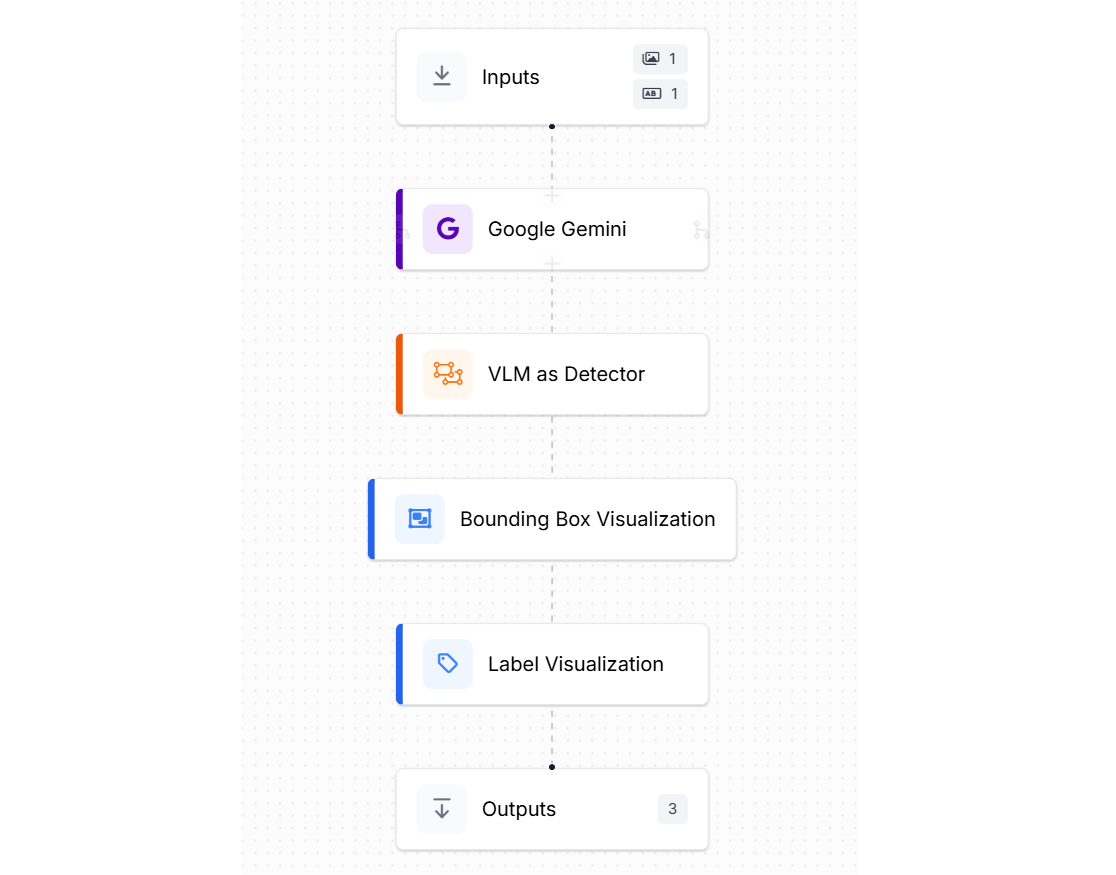
The input block is similar to the above example with class labels and image upload.
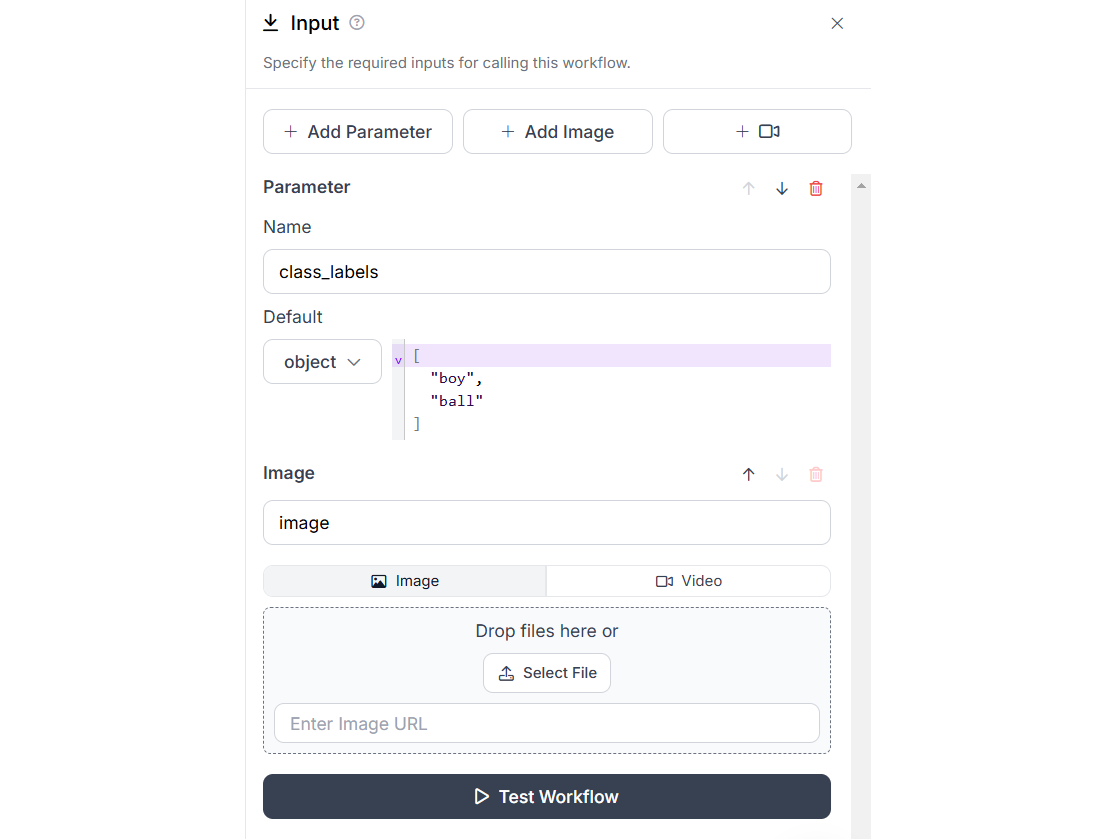
Add the Google Gemini, VLM as Detector and Label Visualization and Bounding Box Visualization blocks to your workflow. We will use Google Gemini for task type “Unprompted Object Detection” as we want to detect the object by specifying class labels only in input block. Following is the configuration for Google Gemini block.
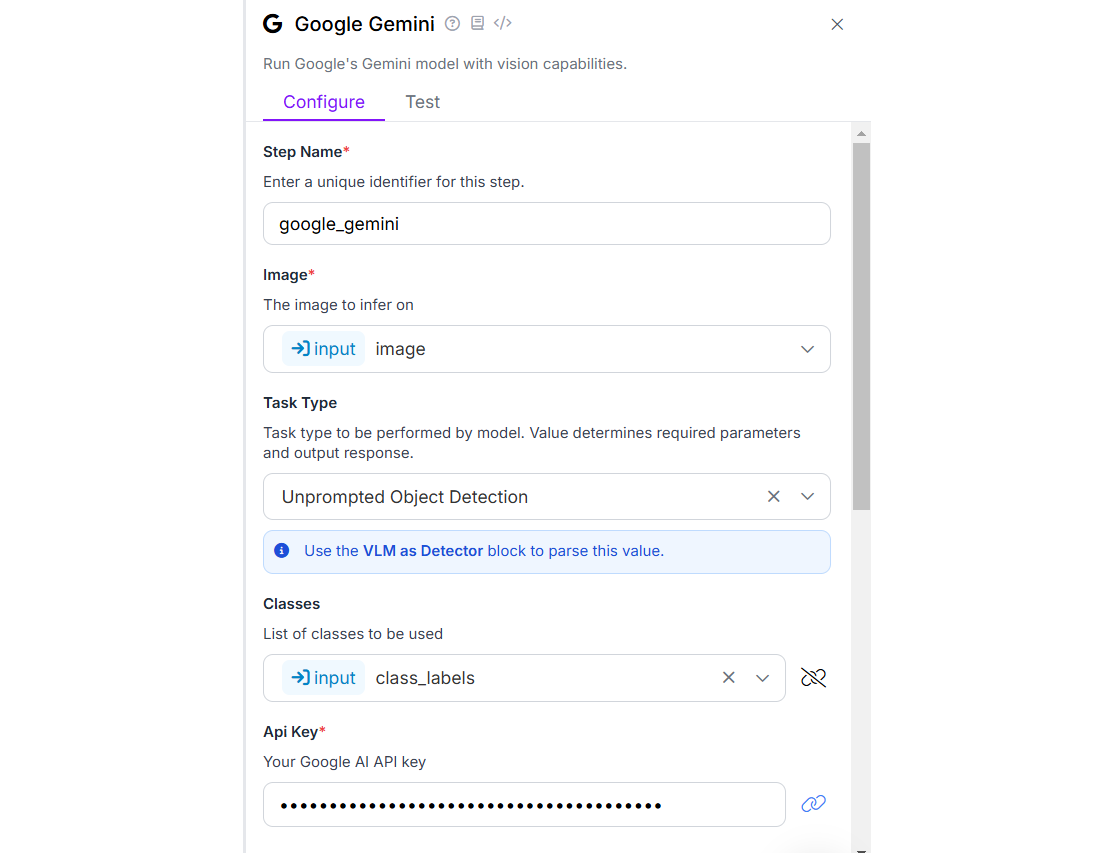
Now configure Bounding Box Visualization block as shown below.
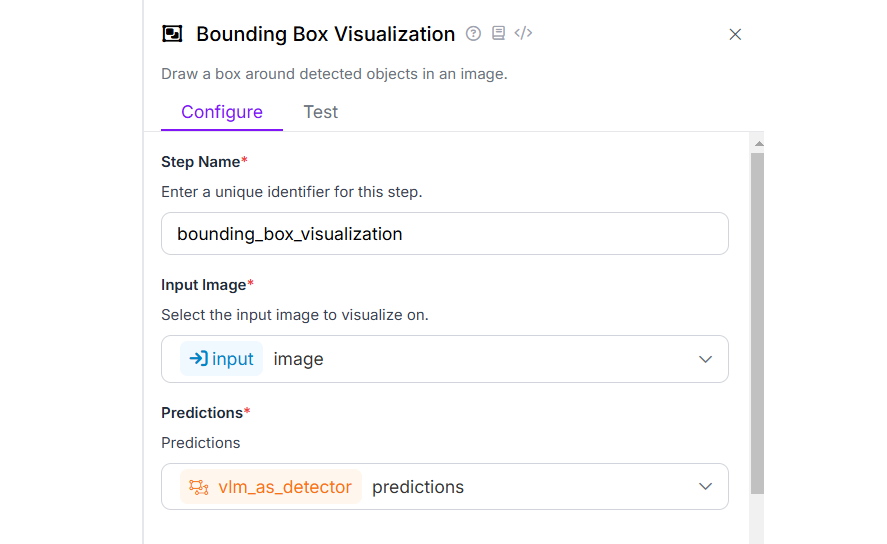
Also configure Label Visualization block after that to display labels with bounding boxes in the output image.
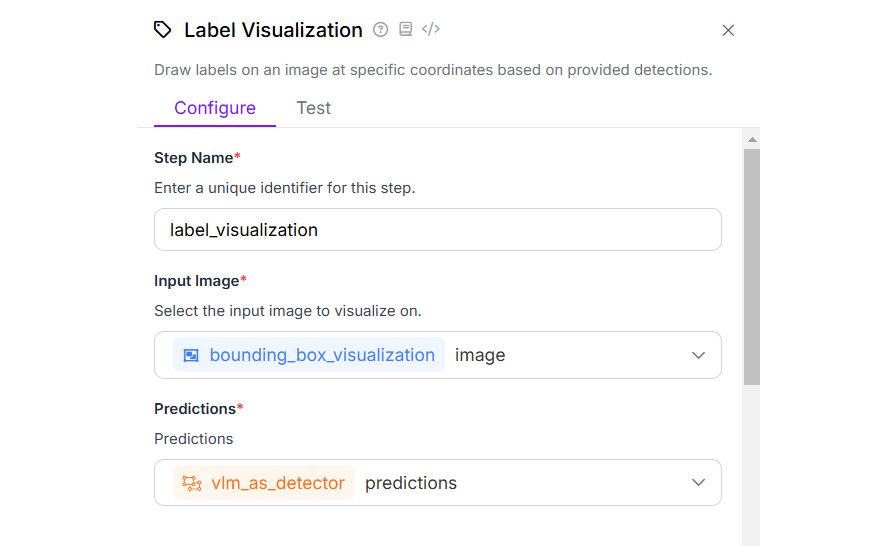
Finally, the output block should look like following.
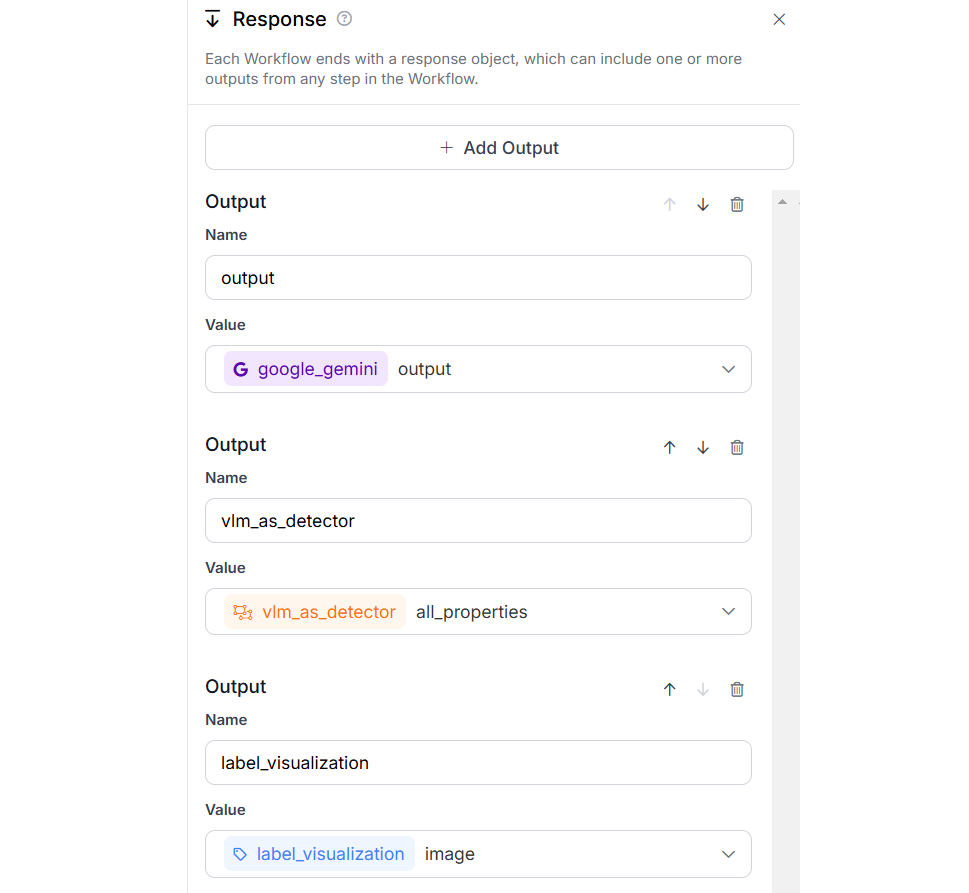
When you run this workflow, you will see following output.
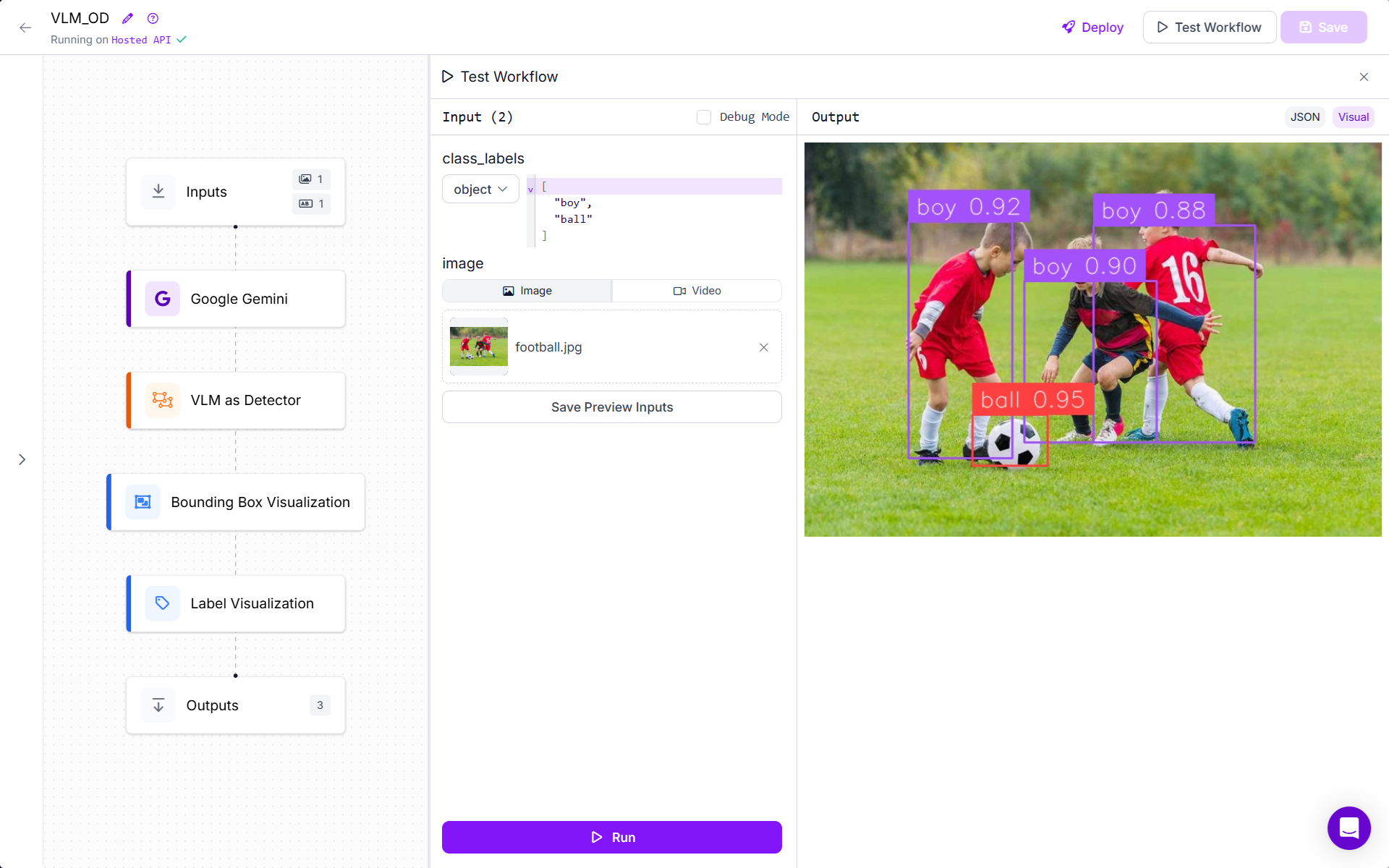
Image Captioning
Image Captioning is the task of generating a textual description of an image. The model generates a descriptive sentence about what it sees in an image. For example, given a park photo, it might generate "A young family is having a picnic under a large oak tree on a sunny day." This requires not just identifying objects but understanding their relationships and context to create coherent, meaningful descriptions.
For our example we will create image captioning workflow using Llama 3.2 Vision block. Configure “Task Type” as “Captioning (Short)” or “Captioning” in the Llama 3.2 Vision block. When you run the workflow, you will see the following output.

Visual Question Answering (VQA)
Visual Question Answering (VQA) represents a more interactive form of image understanding. The model must answer specific questions about an image, requiring it to understand both the visual content and natural language queries. For instance, given an image of a kitchen and the question "What color is the refrigerator?", the model needs to locate the refrigerator, identify its color, and formulate an answer. This demonstrates a deeper level of image comprehension and reasoning.
For our example we will create a VAQ Workflow using Llama 3.2 Vision block. First configure the input block with parameter “question” and image input.

Then add Llama 3.2 Vision block and configure it with task type as “Visual Question Answering” and bind the prompt field with the “question” parameter.
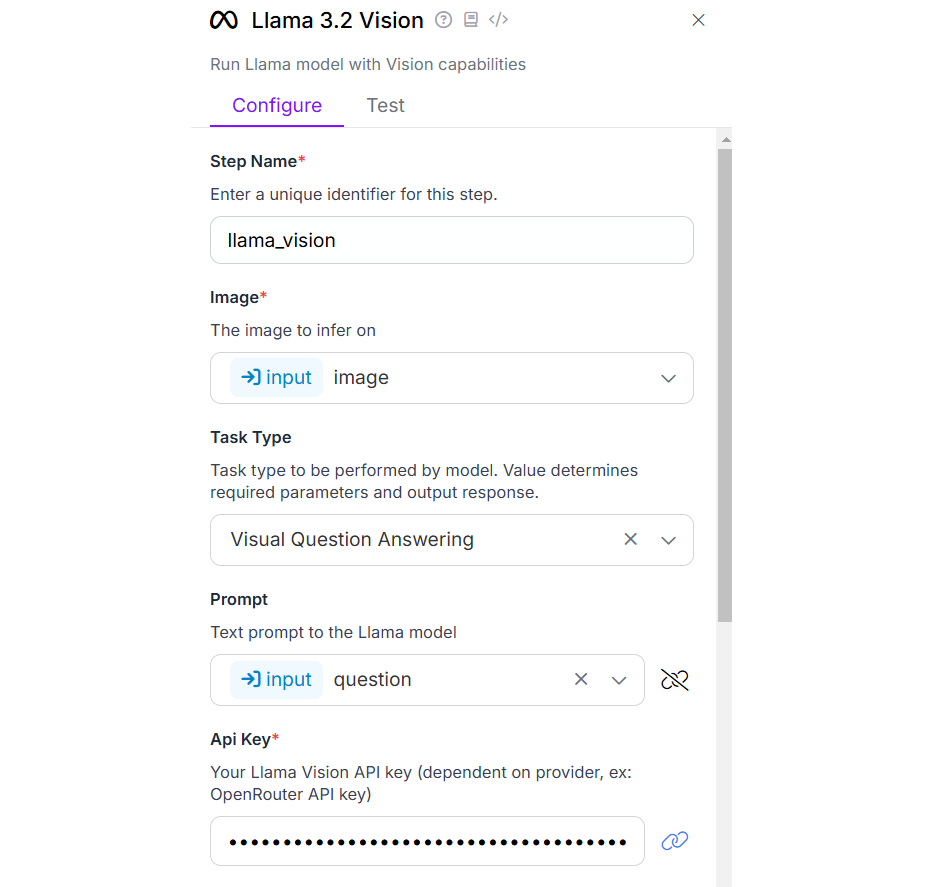
Run the Workflow, add question and upload the image. You will see the following output.
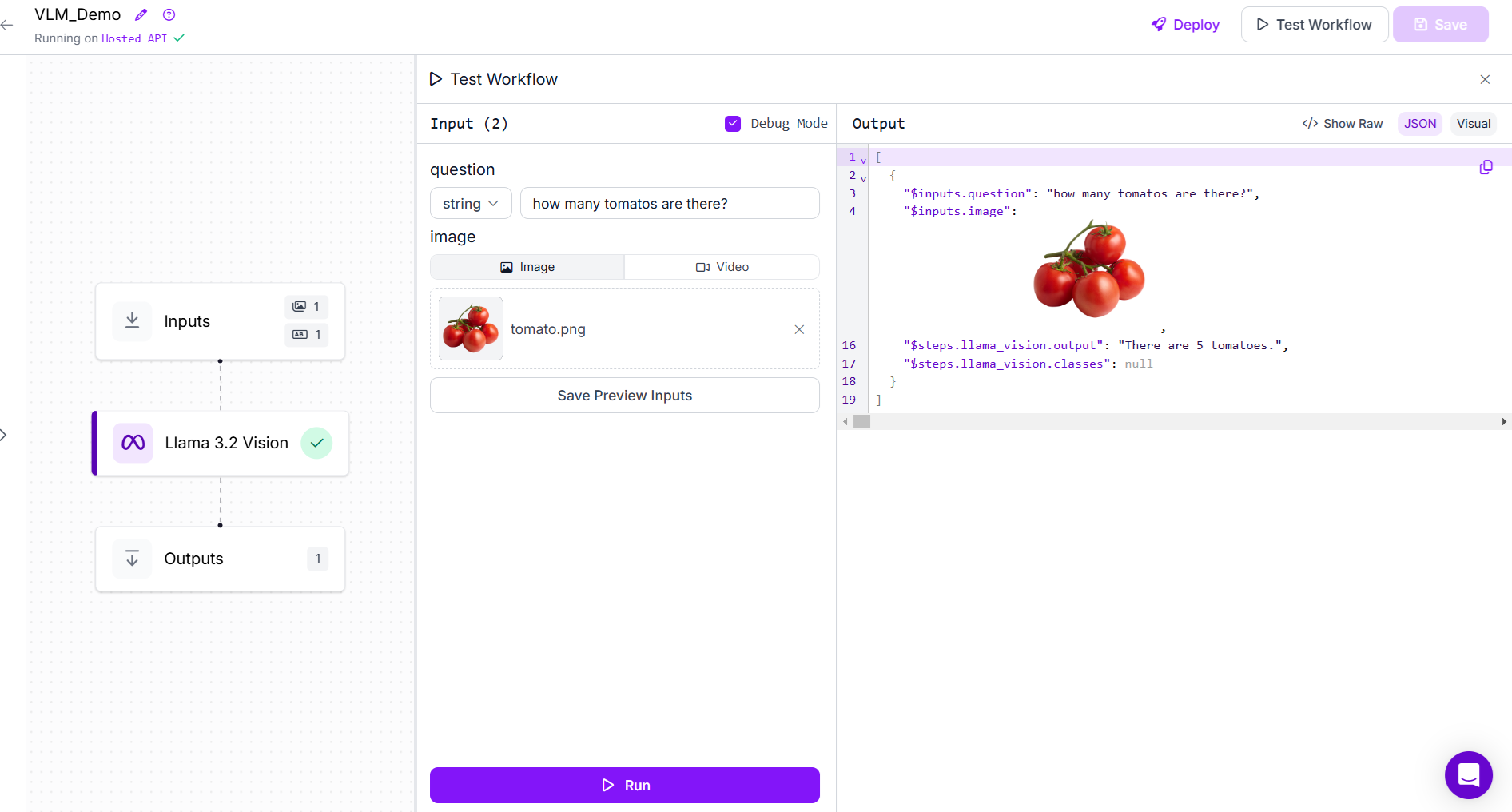
Text Recognition (OCR)
Text Recognition, often called Optical Character Recognition (OCR), is the process of detecting and converting text within images into machine-readable text. Read the blog What is OCR Data Extraction? to learn how to extract text from image using VLM.
For our example we will create a Text Recognition (OCR) Workflow using Llama 3.2 Vision block. Configure “Task Type” as “Text Recognition (OCR)” in the Llama 3.2 Vision block. When you run the workflow, you will see the following output.
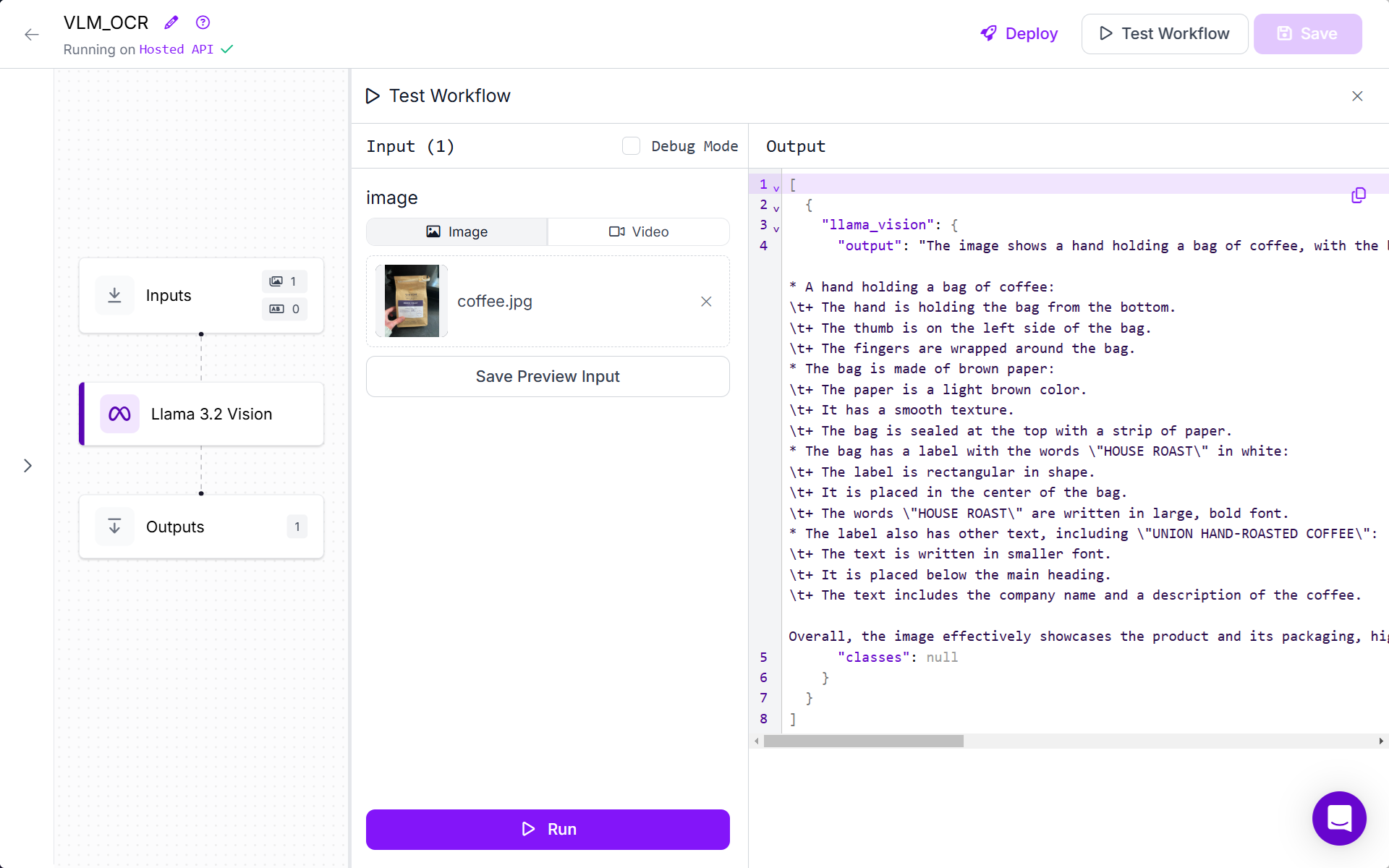
When and Why Should You Fine-Tune a Vision-Language Model?
In the initial phase, known as pre-training, a VLM is trained on large datasets that include both images and text. The goal here is to learn general representations that capture broad relationships between visual and textual data. For example, models like Paligemma-2 learn to align images and their corresponding captions by maximizing similarity between matching pairs.
Fine-tuning a Visual-Language Model (VLM) refers to the process of taking a model that has been pre-trained on large, general datasets and adapting it to perform a specific task or to work well in a particular domain. This process involves training (or “tuning”) the pre-trained model on a smaller, task-specific dataset, allowing the model to adjust its parameters so that it can handle the new task more effectively.
So, after pre-training, the model is further trained on a smaller, task-specific dataset. Fine-tuning adjusts the learned representations to improve some target task, such as image captioning, VQA, or even specialized tasks in specific domains like medical imaging or satellite imagery etc.

Fine-Tuning VLM may be required for various reasons such as following:
Domain Adaptation
Domain adaptation is about adjusting a pre-trained model to work well in a new, specialized area (domain) where the data is different from what the model was originally trained on. This is important because different domains often have unique characteristics, like specific words, phrases, or visual styles. For example, in industrial settings, a general model may struggle to detect machine defects, but fine-tuning it with factory-specific images improves its detection capabilities.
Task-Specific Performance
Fine-tuning helps a model focus on a specific task by adjusting its general knowledge to fit the requirements. This improves the model’s accuracy and relevance for that particular job. Suppose you have a pre-trained image recognition model that can identify common objects like cats, dogs, and cars. Now, you want to use it to detect defects in manufacturing products (e.g., scratches on metal parts). The model might not perform well initially because it wasn’t trained for this specific task. By fine-tuning it on a dataset of defective and non-defective product images, the model learns to focus on the features that matter for defect detection, like scratches or dents, and becomes much better at this specific job.
Efficiency and Resource Utilization
Fine-tuning is more effective than training a model from scratch because it builds on what the model already knows. This reduces the need for massive datasets and computational power, and the model learns faster. For example, instead of training a self-driving car’s vision system from zero, fine-tuning a general object recognition model with driving-specific images speeds up the process and reduces costs.
Customization and Flexibility
Fine-tuning allows you to adapt a model to new tasks or improve its performance without starting over. This makes the model flexible and customizable for different needs. For example, a chatbot trained on general conversation data may not understand legal terminology. Fine-tuning it with legal documents enables it to provide better responses for law-related queries.
Use the Best Vision-Language Models
VLMs combine computer vision and natural language processing and allow machines to understand and create content that involves both images and text. These models can perform many tasks, like identifying objects in images, reading text from pictures (OCR), or answering questions about visuals.
Some popular VLMs are PaliGemma-2, Florence-2, CogVLM, and Llama 3.2-Vision. Fine-tuning these models helps them perform better in specific tasks to make them more useful for specialized applications.
Cite this Post
Use the following entry to cite this post in your research:
Timothy M. (Feb 3, 2025). Comprehensive Guide to Vision-Language Models. Roboflow Blog: https://blog.roboflow.com/what-is-a-vision-language-model/
